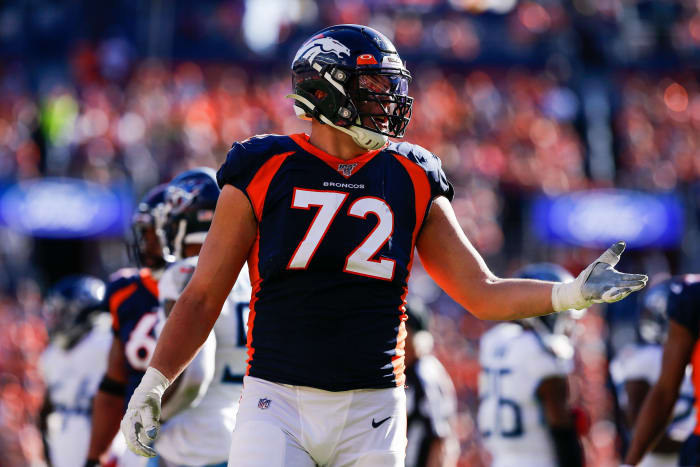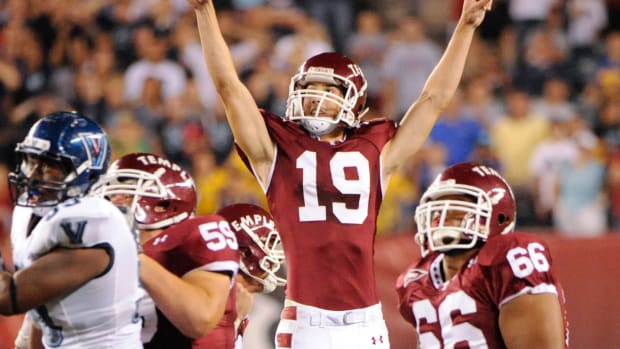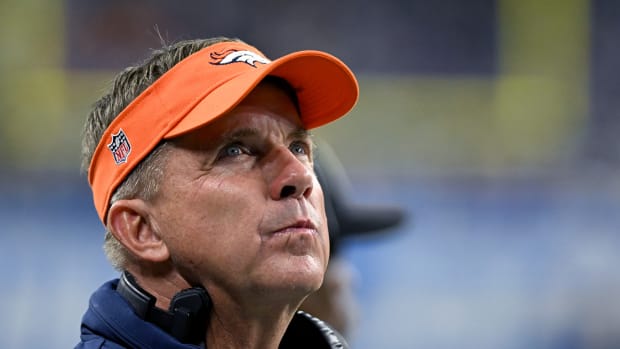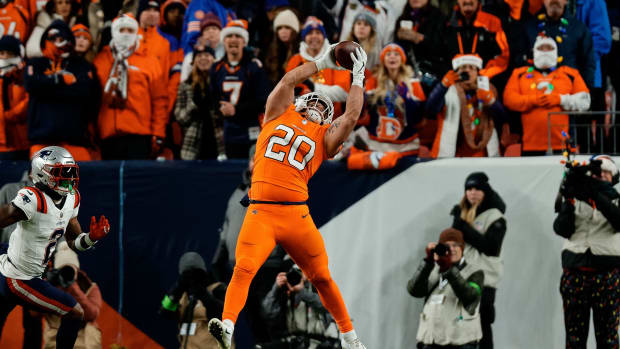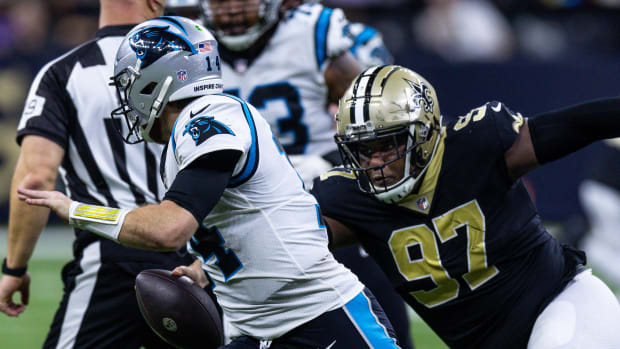Broncos are Waiting to Make a Decision on Garett Bolles' Fifth-Year Option; Here's Why
The Denver Broncos have a difficult decision coming up this offseason. No, that decision doesn’t have anything to do with retaining free agents such as Justin Simmons, Shelby Harris, Derrick Wolfe, or Chris Harris, Jr. or even which direction the team should go in with the plethora of cap space Denver currently possesses.
No, that decision also isn’t where the GM John Elway and the Broncos should go with the No. 15 overall pick. That decision is what to do with the fifth-year option for 2017 first-round offensive tackle Garett Bolles.
Asked about the choice on whether or not the team would pick up Bolles’ fifth-year option at Elway’s annual press conference at the NFL Scouting combine, Elway responded that the team had yet to make a choice per Nicki Jhabvala of The Athletic.
This undoubtedly will cause a large portion of Broncos Country to audibly moan feeling the onset of a headache thinking about a ref exclaiming “Holding, offense, number Seventy-Two” echoing in their memories.
How could the Broncos want to stick with Bolles at left tackle after three struggling seasons, let alone exercise the fifth-year option on his rookie contract which would come with a pay raise? Here are five plausible reasons.
Supply & Demand
There are far less starting-caliber tackles than starting tackle spots in the NFL. The simple fact of the matter is, quality tackle play is one of the scarcest assets in the NFL. While not to the level of value that is a franchise quarterback, the fact that there are 64 starting tackle spots with only about 40-50 starting-caliber tackles in a given year makes tackle one of the most sought after positions in the NFL.
In a league trending further down the rabbit hole of 'passing game over everything' the value of tackle will continue to increase.
For as maddening as Bolles’ penalties have been, an eye-popping 45 called during his three seasons in Denver, he has provided value given he has been playing starting-level tackle play on a rookie contract. Averaging just $2.76 million per season over his rookie contract for the Broncos, Bolles even playing at bottom-tier starting tackle level is a return on investment given how absolutely stupid the tackle market is in free agency.
With the Arizona Cardinals paying former first-round pick D.J. Humphries a three-year, $45 million dollar contract, averaging $15M a year good for the fifth-highest average pay offensive tackle in the NFL, expect the wackiness of the tackle market to continue.
Low Supply + High Demand = Inflated Cost
Again, the OT market in free agency is absolutely insane and hardly ever provides a worthy return on investment. For comparison, the aforementioned Humphries has earned an average offensive grade from Pro Football Focus of 71.15, whereas Bolles has averaged an offensive grade of 73.90.
Humphries did start to show some promise in his fourth season in the NFL, but is at best an equivalent to Bolles. Yet, he is now the fifth highest-paid OT in the entire NFL. Further digging into the insanity that is free-agent OTs, look no further than Nate Solder whom many in Broncos Country were pining for a few seasons ago.
Now the fourth highest-paid OT per season making $14.5 million, Solder has struggled immensely and been a significant cap burden for the Giants since they regrettably backed up the Brinks truck for an average and depreciating talent on the open market.
Even if Bolles maintains his level of play in 2020 that he has shown the past two seasons, his level of play at his cost provides a return on investment as just the 55th highest-paid OT in the NFL in terms of average yearly pay. However, there is significant data that should point to Bolles’ fourth season in the NFL being his best season yet.
OTs Take Longest to Develop
In a statistical study conducted by Timo Riske of Pro Football Focus in regards to the learning curve for players coming from the draft to solidifying who they will be for a majority of their careers, one of the main findings was that offensive line takes as long as any position to adjust level-out for their careers. The findings, in regards to OTs specifically:
1.) Offensive linemen struggle during their rookie season much more than other positions and, maybe even more interestingly, offensive linemen don't reach their full potential before Year 3 or even Year 4.
2.) Offensive tackles, in particular, seem to constantly develop throughout their rookie contract, as the recent example of D.J. Humphries illustrates. Humphries turned into a solid pass protector in his fourth year and earned himself an extension. While one should still exercise caution when observing a sudden breakout for an offensive lineman in Year 4, our findings yield an encouraging result and should increase our confidence in such performances being sustainable.
This means that one shouldn't give up on struggling offensive linemen too early, especially if they came into the league with a high draft stock. There is usually still plenty of hope that they could develop into the player they were supposed to be when drafted. Especially for tackles, who command higher salaries on the free market, this could mean that exercising the fifth-year option after three years could be valuable even if the player hasn't fulfilled the high expectation of a first-round pick.
Given that 2020 will be the first time in his professional career that Bolles will be playing back-to-back seasons with the same left guard next to him and being coached under the same offensive line coach, none other than arguably the best in the entire game in Mike Munchak, there is reason to have hope for him to develop beyond an average level starting tackle in the NFL.
Furthermore, Bolles was raw entering the league having only played one season of division one football at tackle before being drafted. The latency curve on his development should have been expected, especially knowing this data now in hindsight.
Bolles Improved Down the Stretch
Not only is the arrow for Bolles trending up, but so is his play. From the bye week onwards, Bolles saw a marked improvement in his play with his penalties dropping from eleven Weeks 1-9 to six from Weeks 11-17.
Furthermore, Bolles’ surrendered pressures fell off a cliff giving up 20 hurries and four sacks before the bye week to just three hurries and zero sacks from Week 11 to the end of the season. Bolles did show similar improvement at the end of the 2018 season, so hopes that it finally ‘clicked’ can be met with skepticism, but can also be countered equally with optimism given continuity and the data of when tackles tend to finally catch up to the NFL game.
Despite general consensus, Bolles overall had a solid 2019 season. Earning a grade of 76.0 from PFF, Bolles ended up as the 11th highest-rated offensive tackle in the NFL amongst his positional peers that played at least 80% of their team’s offensive snaps. Bolles is far closer to ‘solid’ than a nightmare at tackle compared to tackles across the league.
2020 Starter? Probable
John Elway and Vic Fangio have all but flat-out said Bolles will be starting at tackle come 2020, as well as any insider when pressed upon the issue. However, the issue gets more complicated when discussing if the Broncos should exercise the fifth-year option or not for Bolles.
Given current projections, exercising the fifth-year option would cost approximately $12M, or about the 15th highest average salary. This will likely be reset though by the time Jack Conklin is paid this offseason, as well as young tackle talent in Ronnie Stanley, Laremy Tunsil, Taylor Decker, Ryan Ramczyk, Cam Robinson, and Dion Dawkins should all have have new massive contracts soon that continually reset the market for OTs.
On top of the return on investment and flexibility the Broncos can obtain by placing the fifth-year option on Bolles, the option is only guaranteed for one thing; injury. Some speculation that the option with the new CBA deal pending might become fully guaranteed but all current indication is that the fifth-year option for the 2017 draft class would remain the same as the previously agreed to CBA with future options being impacted.
With Bolles having never missed a start in three years, the risk in placing the fifth-year option in Bolles seems minimal at best. If he fails and remains healthy, the Broncos can rescind the option after next season with no impact on their salary cap.
Why Wait?
Given all this data, why would the Broncos wait until the deadline of May 30 to exercise the fifth-year option on Bolles? Simply put, it comes down to flexibility.
With the amount of resources poured into Ja’Wuan James already, the Broncos have no reason to rush and place the fifth-year option on Bolles until after free agency and the draft. The odds of the team paying a tackle in free agency is minuscule, but never say never.
What is far more likely is that if the board falls a certain way, or even if the Broncos’ fall in love with a singular tackle prospect and move up, Denver may walk out of round one with a tackle that would not only push Bolles and James in 2020, but provide a long-term (and cheap compared to market value!) tackle option.
With the 2020 draft considered to have one of the better crops of tackles at the top of the class than any in recent memory, Denver should absolutely look at their options in adding an offensive tackle in the upcoming Draft. While falling from pick 10 to 15 by beating the Raiders really limited the team’s chances in drafting a tackle, falling behind the absolutely tackle desperate Browns and Jets, crazy things can happen.
The current consensus is that there will be five OTs drafted in the top-20 of the upcoming draft in Louisville’s Mekhi Becton, Iowa’s Tristan Wirfs, Alabama’s Jedrick Wills, Jr., Georgia’s Andrew Thomas, and Houston’s Josh Jones. It is possible almost all of them are gone before Denver even is on the clock given the number of tackle-hungry teams picking in front of Denver, but if the draft is anything, it is unpredictable.
If not those five, there are other highly thought of tackle prospects that could go anywhere from Denver’s first and second-round pick in TCU’s Lucas Niang, USC’s Austin Jackson, Georgia’s Isaiah Wilson, and Auburn’s Prince Tega Wanogho.
Bottom Line
In the end, the Broncos may not exercise the fifth-year option on Bolles’ rookie contract. His play has been up and down and most people demand better than average starting play from a first-round pick.
Many fans already have their mind made up on who Bolles is and will not be swayed given new data or improved play down the stretch. Luckily, the Broncos do not make their decisions based on mob mentality of the loudest and angriest fans.
Whether the Broncos exercise the fifth-year option on Bolles or not remains to be seen as the team should, can, and will wait as long as possible to make that call, but that decision is far more likely to be a 'yes' than general consensus would have you believe.
Follow Nick on Twitter @NickKendellMHH and @MileHighHuddle.
